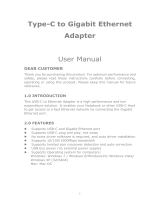
1
Chapter 1: Introduction
Welcome
Wireless-N Gigabit Router with Storage Link
Chapter 1: Introduction
Welcome
The Wireless-N Gigabit Router with Storage Link is really four devices in one box. First, there's the Wireless
Access Point, which lets you connect to the network without wires. There's also a built-in 4-port full-duplex
Gigabit Switch to connect your wired-Ethernet devices together. The Router function ties it all together and lets
your whole network share a high-speed cable or DSL Internet connection.
We've also included a Storage Link that lets you easily add gigabytes of storage space onto your network using
readily available USB 2.0 hard drives—or plug in a USB flash disk for a convenient way to access your portable
data files. And you can get to your files from anywhere in the world through the Internet.
The Access Point built into the Router uses the very latest wireless networking technology, Wireless-N (draft
802.11n). By overlaying the signals of multiple radios, Wireless-N's “Multiple In, Multiple Out” (MIMO) technology
multiplies the effective data rate. Unlike ordinary wireless networking technologies that are confused by signal
reflections, MIMO actually uses these reflections to increase the range and reduce “dead spots” in the wireless
coverage area. The robust signal travels farther, maintaining wireless connections up to 4 times farther than
standard Wireless-G.
With Wireless-N, the farther away you are, the more speed advantage you get. It works great with standard
Wireless-G and -B equipment, but when both ends of the wireless link are Wireless-N, the router can increase the
throughput even more by using twice as much radio band, yielding speeds up to 12 times as fast as standard
Wireless-G. But unlike other speed-enhanced technologies, Wireless-N can dynamically enable this
double-speed mode for Wireless-N devices, while still connecting to other wireless devices at their respective
fastest speeds. In congested areas, the “good neighbor” mode ensures that the Router checks for other wireless
devices in the area before gobbling up the radio band.
To help protect your data and privacy, the Router can encode all wireless transmissions with industrial-strength
256-bit encryption. It can serve as your network's DHCP Server, has a powerful SPI firewall to protect your PCs
against intruders and most known Internet attacks, and supports VPN pass-through. Configuration is a snap with
the web browser-based configuration utility.
The incredible speed of Wireless-N makes it ideal for media-centric applications like streaming video, gaming,
and Voice over IP telephony, and gives you plenty of headroom to run multiple media-intense data streams
through the network at the same time, with no degradation in performance. With the Linksys Wireless-N Gigabit
Router with Storage Link at the center of your home or office network, you can easily add storage, share a high-
speed Internet connection, files, printers and multi-player games, and run media-intensive applications at faster
than 10/100 wired network speeds, without the hassle of stringing wires!
lan (local area network): The computers and
networking products that make up the network in
your home or office.
nat (network address translation): NAT technology
translates IP addresses of a local area network to a
different IP address for the Internet.
spi (stateful packet inspection) firewall: a technology
that inspects incoming packets of information before
allowing them to enter the network.
firewall: Security measures that protect the
resources of a local network from intruders.




















